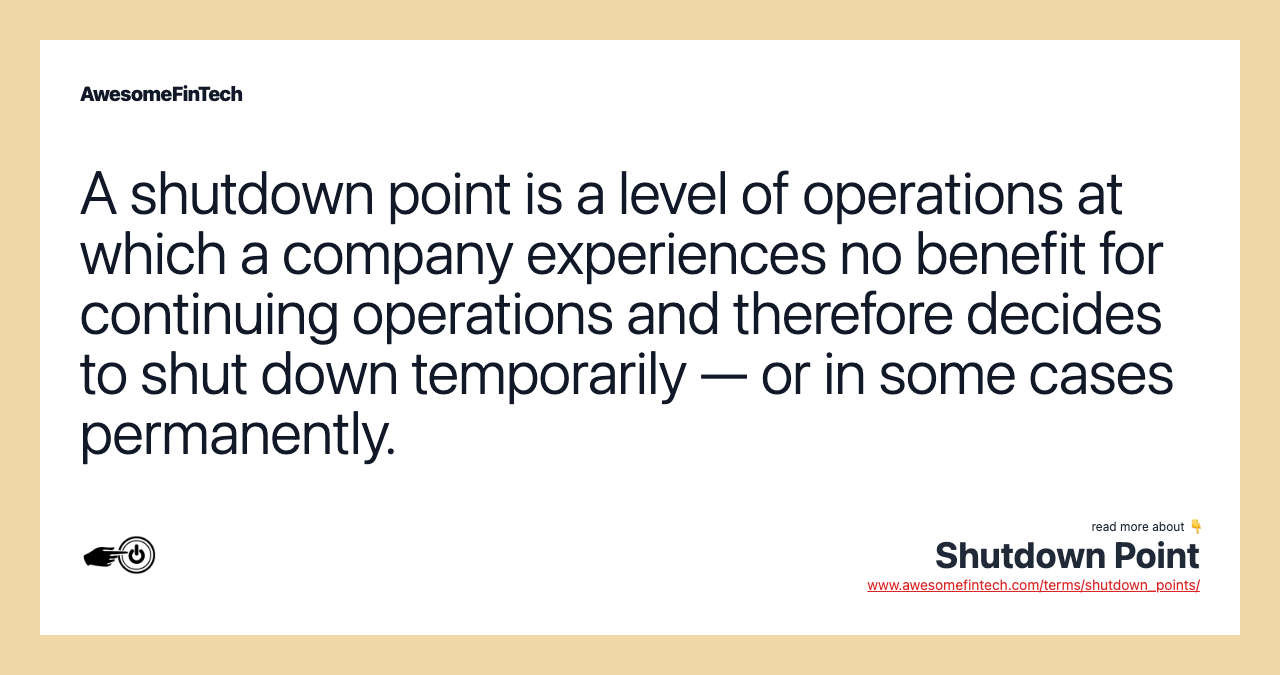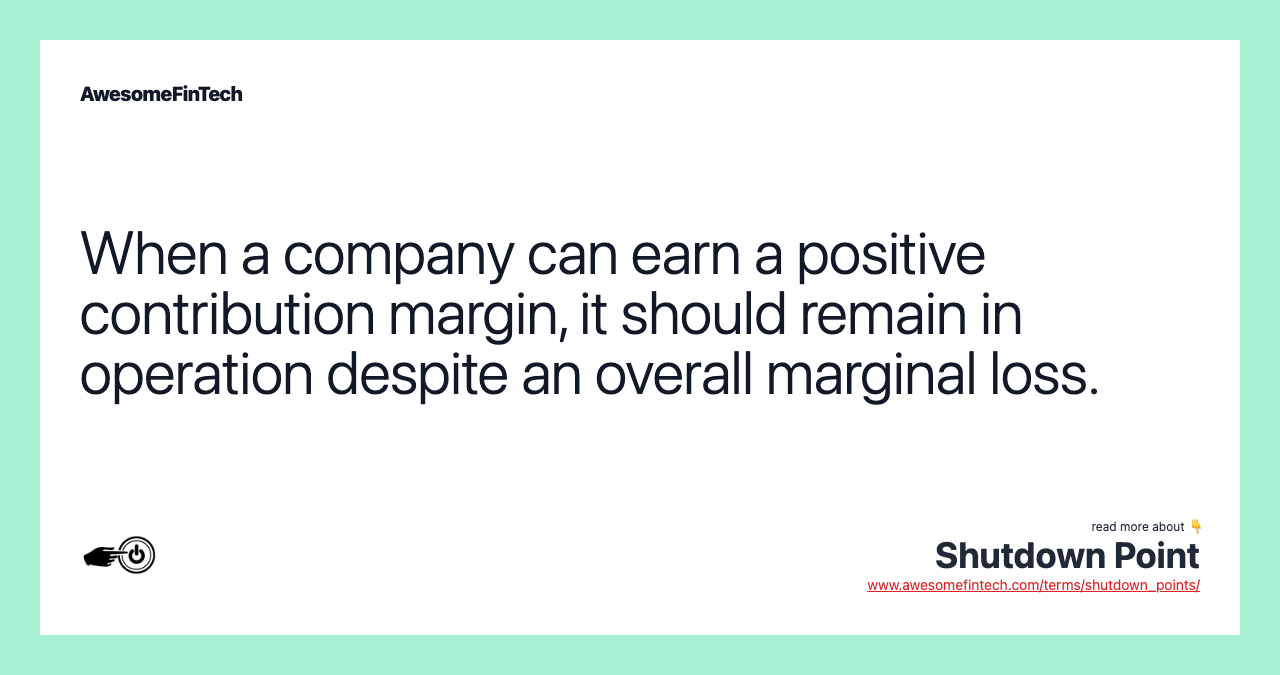Shutdown Point
A shutdown point is a level of operations at which a company experiences no benefit for continuing operations and therefore decides to shut down temporarily — or in some cases permanently. Shutdown points are based entirely on determining at what point the marginal costs associated with operation exceed the revenue being generated by those operations. When a company can earn a positive contribution margin, it should remain in operation despite an overall marginal loss. If a company can produce revenues greater or equal to its total variable costs, it can use the additional revenues to pay down its fixed costs, assuming fixed costs, such as lease contracts or other lengthy obligations, will still be incurred when the firm shuts down. The shutdown point denotes the exact moment when a company’s (marginal) revenue is equal to its variable (marginal) costs — in other words, it occurs when the marginal profit becomes negative. A shutdown point is a level of operations at which a company experiences no benefit for continuing operations and therefore decides to shut down temporarily — or in some cases permanently.

What Is a Shutdown Point?
A shutdown point is a level of operations at which a company experiences no benefit for continuing operations and therefore decides to shut down temporarily — or in some cases permanently. It results from the combination of output and price where the company earns just enough revenue to cover its total variable costs. The shutdown point denotes the exact moment when a company’s (marginal) revenue is equal to its variable (marginal) costs — in other words, it occurs when the marginal profit becomes negative.




How the Shutdown Point Works
At the shutdown point, there is no economic benefit to continuing production. If an additional loss occurs, either through a rise in variable costs or a fall in revenue, the cost of operating will outweigh the revenue.
At that point, shutting down operations is more practical than continuing. If the reverse occurs, continuing production is more practical. If a company can produce revenues greater or equal to its total variable costs, it can use the additional revenues to pay down its fixed costs, assuming fixed costs, such as lease contracts or other lengthy obligations, will still be incurred when the firm shuts down. When a company can earn a positive contribution margin, it should remain in operation despite an overall marginal loss.
A shutdown point can apply to all of the operations a business participates in or just a portion of its operations.
Special Considerations
The shutdown point does not include an analysis of fixed costs in its determination. It is based entirely on determining at what point the marginal costs associated with operation exceed the revenue being generated by those operations.
Certain seasonal businesses, such as Christmas tree farmers, may shut down almost entirely during the off-season. While fixed costs remain during the shutdown, variable costs can be eliminated.
Fixed costs are the costs that remain regardless of what operations are taking place. This can include payments to maintain the rights to the facility, such as rent or mortgage payments, along with any minimum utilities that must be maintained. Minimum staffing costs are considered fixed if a certain number of employees must be maintained even when operations cease.
Variable costs are more closely tied to actual operations. This can include but is not limited to, employee wages for those whose positions are tied directly to production, certain utility costs, or the cost of the materials required for production.
Types of Shutdown Points
The length of a shutdown may be temporary or permanent, depending on the nature of the economic conditions leading to the shutdown. For non-seasonal goods, an economic recession may reduce demand from consumers, forcing a temporary shutdown (in full or in part) until the economy recovers.
Other times, demand dries up completely due to changing consumer preferences or technological change. For instance, nobody produces cathode-ray tube (CRT) televisions or computer monitors any longer, and it would be a losing prospect to open a factory these days to produce them.
Other businesses may experience fluctuations or produce some goods year-round, while others are only produced seasonally. For example, Cadbury chocolate bars are produced year-round, while Cadbury Cream Eggs are considered a seasonal product. The main operations, focused on the chocolate bars, may remain operational year-round, while the cream egg operations may go through periods of a shutdown during the off-season.
Related terms:
Accounting
Accounting is the process of recording, summarizing, analyzing, and reporting financial transactions of a business to oversight agencies, regulators, and the IRS. read more
Income From Continuing Operations
Income from continuing operations is a net income category found on the income statement that accounts for a company’s regular business activities. read more
Contribution Margin , Formula, & Ratio
Contribution margin is a cost-accounting calculation that tells a company the profitability of an individual product, or the revenue that is left after covering fixed costs. read more
Cost-Volume-Profit (CVP) Analysis
Cost-volume-profit (CVP) analysis looks at the impact that varying levels of sales and product costs have on operating profit. read more
Fixed Cost
A fixed cost is a cost that does not change with an increase or decrease in the amount of goods or services produced or sold. read more
Government Shutdown
In a government shutdown, which is caused by delays in the approval of the next fiscal year budget, nonessential government offices close due to funding needs. read more
Marginal Profit
Marginal profit is the profit earned by a firm or individual when one additional unit is produced and sold. read more
Production Costs
Production costs are incurred by a business when it manufactures a product or provides a service. These costs include a variety of expenses. read more
Recession
A recession is a significant decline in activity across the economy lasting longer than a few months. read more
Variable Overhead
Variable overhead is the indirect cost of operating a business, which fluctuates with manufacturing activity. read more